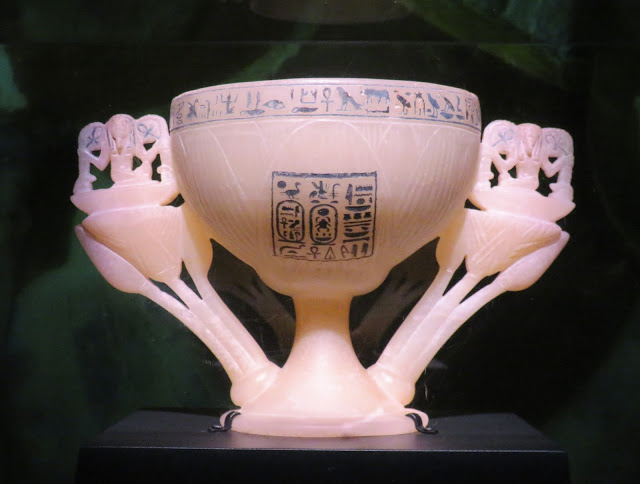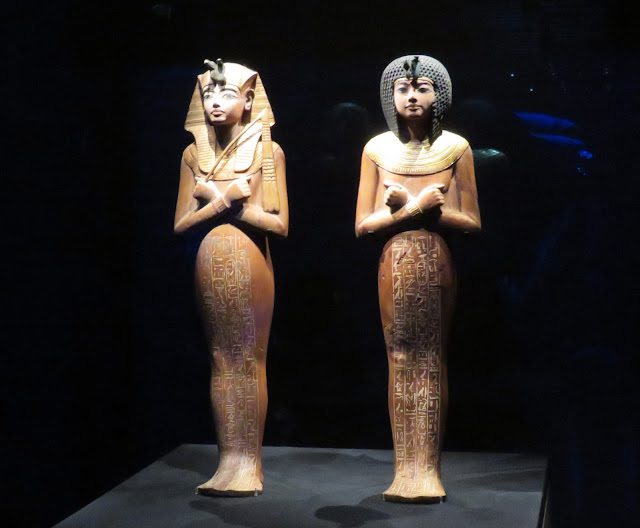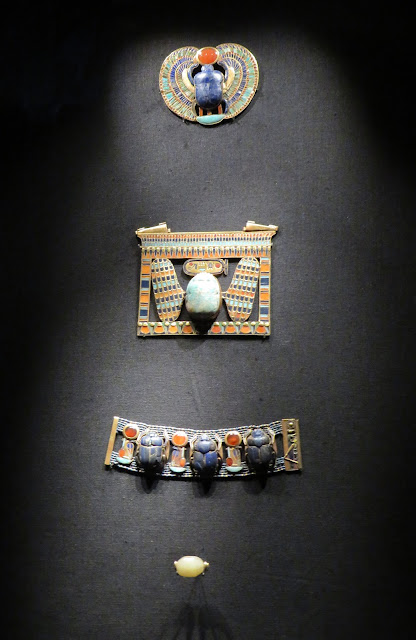Tutankhamun Exhibition in London
I have just been to the Tutankhamun exhibition at the Saatchi Museum in London - the last time these artefacts will be on show - before returning to their new permanent home, near the pyramids of Giza in Egypt. As well as having 150 of the most fabulous pieces on show (in 5 very different galleries), there were many of these items that have never been seen outside of Egypt. There were also photographs and film coverage of when the tomb was discovered, plus modern film clips made to explain what certain pieces were and how they were used.
Tutankhamun was born about 1340 BC, the son of Pharaoh Amenhotep 4th aka Akhenaton, and although the name of his mother isn't known but she was probably Akhenaton's sister (Due to DNA discoveries). He was originally called Toutankhaton (the living image of Aton) but changed his name to Tutankhamun - to affirm his allegiance to the god Amon. His reign was short lived though - dying at the young age of 19.
Tutankhamum came to the throne at the age of 8 or 9, and married his half sister the Princess Ankhesenamon (her mother was Nefertiti) - they were the only surviving children of Akhenaton. Tutankhamun and Ankhesenamon had 2 daughters who died at birth - and these were buried with their father.
You can learn more about when and how the tomb was discovered in 1922 by Howard Carter, who had been excavating antiquities for over 30 years. This was to be his last dig in this area - as funding from Lord Carnarvon was almost at an end. See photos of what they saw when they first entered a tomb that had been sealed for over 3000 years - and treasure that was intended to accompany Tutankhamun on his journey into the afterlife. It revealed so much about royal life in ancient Egypt.
They found 2 "Guardians" that stood at the sealed entrance to the burial chamber - this is only one of them. The antechambers contained over 5000 artefacts and it took Howard Carter a decade to catalogue them all and empty the tomb.

As you wander through the first few galleries, you can learn about Egyptians beliefs in the afterlife , stories of magic and spells they needed to successfully travel through the after life and to be reborn.

Here are some of my favourite items that were discovered in Tutankhamun's Tomb.

The Alabaster Wishing Cup - one of the first items to be found.
A calcite vase with a papyrus and lotus flower design.
An inlaid wooden cartouche box.
A painted calcite box which contained 2 bundles of hair - possibly that of Tutankhamun and his wife from their wedding ceremony.
A travelling wooden chest that would have contained items to be offered to the god Osiris.
A boat that would take him on his journey in the afterlife.
The image on here is of Tutankhamun in a chariot - on an ostrich hunt in the desert.
A gilded wooded figure of Tutankhamun standing on a skiff - throwing a harpoon.
A ceremonial gilded wooden shield showing Tutankhamun slaying lions.
An ornate box that would have carried bows and arrows - and the picture below is one end of the box.
A gilded wooden statue of the king riding a black panther - showing his domination.
Another gilded statue showing him on his journey to another life.
Because Tutankhamun was only 9 years old when he came to the throne - special child-size furniture and weapons had to be made for him.
The gilded bed, with its ebony frame was covered with gold, and has carvings of animals on it - that were meant to provide protection.
These are turquoise glass headrests - I don't think they look comfortable enough to sleep on!!!
A gilded statue of Ptah.
Squatting figure of King Amenhopet 3rd - found with a lock of hair belonging to his wife Queen Tiye (she was Tutankhamun's grandmother).
Workers for the afterlife - 413 in total were found - an unusually high number.
The next part was one of my favourites.................Tutankhamun's embalmed organs were kept in 4 exquisite miniature replicas of his coffin - and placed in a calcite chest - with 4 heads then placed above these small coffins. They were magnificent, some of the most beautiful items on display.
Here are a few photographs of the video showing how these parts fitted together in the calcite chest.
Below is a canopied coffinette - dedicated to the gods Imseti and Isis.
Then there was the mummy of Tutankhamun - as it would have been when it was found (but without the Death mask - which has not been allowed out of Egypt).
Inside the burial chamber were 4 nested gilded wooden sarcophagus, which all contained a further 3 nested coffins - all depicting the image of Tutankhamun. The inner most one contained the mummy of the king and the golden Death Mask - made in the likeness of Osiris - the Egyptian god of the afterlife. The solid gold Portrait Death Mask is made from 24 pounds of gold and precious gems; and is described as one of the most famous works of art ever created.
Tutankhamun is holding his crook and flail and surrounded with items of jewellery - many more of which can be seen around the exhibition.

The centre piece here is a beautiful wooden gilded mirror case in the shape of an Anka.
This is a miniature game board where players would have thrown knuckle shaped pieces and moved the discs and cones along the board.
This wooden box is inlaid with ebony and ivory and an inscription on it suggests it is actually decorated with 47000 separate pieces of inlay - and that it held gold for Tutankhamun's wedding.
This is a Gilded Wooden Statue Shrine (encased with a sheet of thick gold) depicting scenes of Tutankhamun and his wife Ankhesenamum going about their daily life. It has a wonderful set of double doors at the front, and there is a photograph of it being removed from the tomb.
This young boy stumbled across an unusual flat rock as he tried to place water jars down for the excavators - and this rock was actually a step. The step that lead down to the undiscovered tomb. Subsequently known as The Water Boy, he was later photographed wearing this ornate sacred necklace and that photograph has held a special place with the family ever since that time.
The remnants of this colossal statue originally had Tutankhamun's name carved on it, but it had been overscribed with the name of the 2 subsequent pharaohs - Ay and Horemheb.
Tutankhamun was described as a forgotten Pharaoh because any inscriptions regarding him had been erased or destroyed - mainly because of his family ties with his father Akhenaton who was known as a rebel. No-one knew he ever existed - that is probably why he was undiscovered for so long.

There are several theories as to how he may have died; originally it was thought he had been murdered because a piece of broken bone was found in his skull. But it was later discovered that the bone ended up there after his death, perhaps when he was being embalmed. He had a slightly curved spine, cleft palate and a club foot - perhaps this is the reason over 100 walking sticks were found in his tomb. He may have had an accident, developed an illness or contracted malaria - which was also discovered in his body. Another mystery that may never be solved!
It is good to see that the mummified body of the king now rests in his tomb in the Valley of the Kings - where it belongs.
Lord Carnarvon died 4 months after entering the tomb - starting a myth - "The Curse of the Pharaohs" - but studies have shown that other people who also entered the tomb didn't have their lives cut short in unexpected ways.
Lord Carnarvon died 4 months after entering the tomb - starting a myth - "The Curse of the Pharaohs" - but studies have shown that other people who also entered the tomb didn't have their lives cut short in unexpected ways.
When the exhibition returns to Egypt next year, it won't ever be leaving there again - I felt so privileged to have been able to see some of these remarkable artefacts close to home.

There is a well stocked shop where you can buy a wide variety of goods ranging from just a few pounds - to some Limited Edition books that cost a staggering £3500.
I hope you enjoyed seeing this fabulous exhibition with me.
Thank you for taking the time to follow my adventures,
Thank you for taking the time to follow my adventures,
Lynne
Please check out my other blogs:-




















































No comments:
Post a Comment